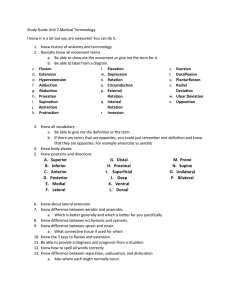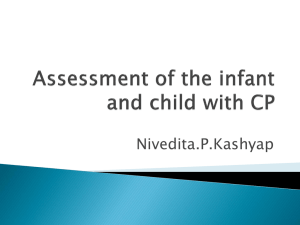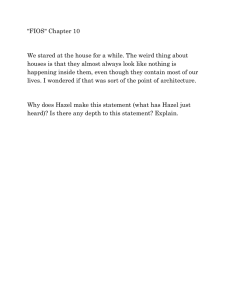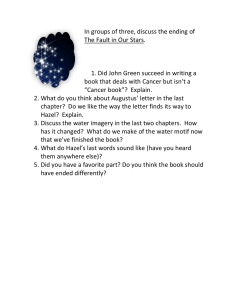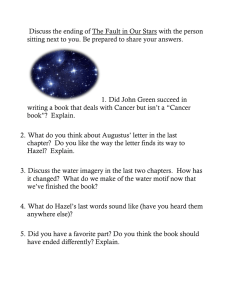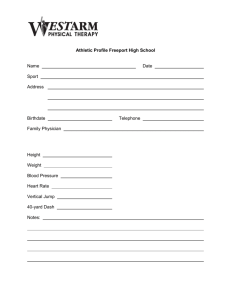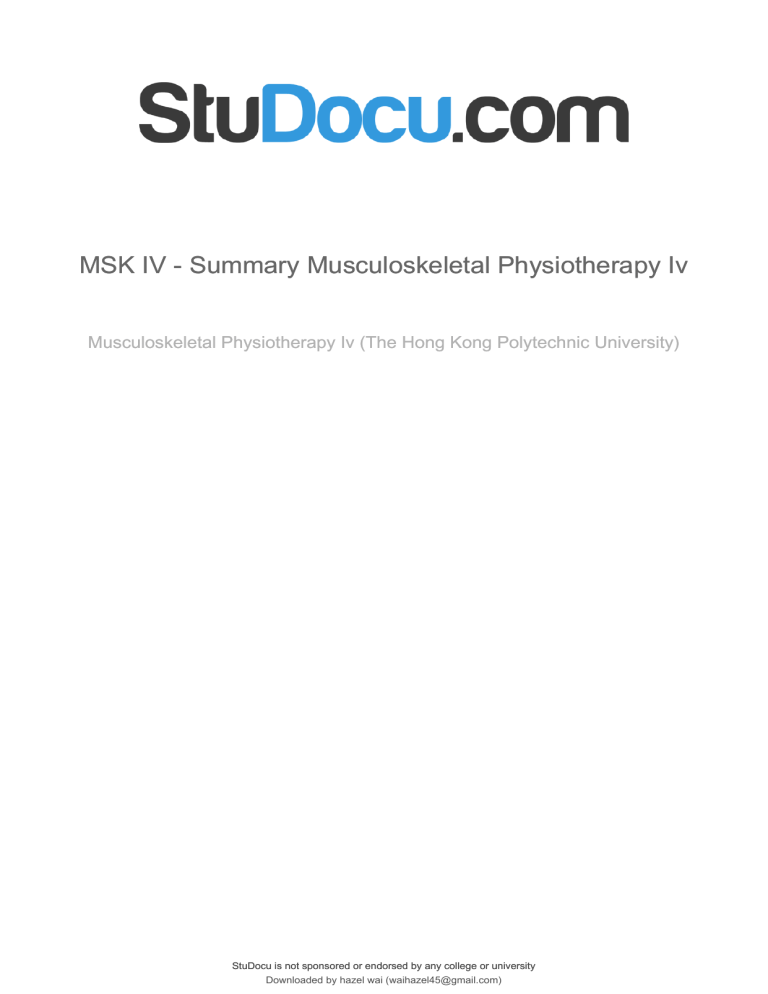
lOMoARcPSD|2973785 MSK IV - Summary Musculoskeletal Physiotherapy Iv Musculoskeletal Physiotherapy Iv (The Hong Kong Polytechnic University) StuDocu is not sponsored or endorsed by any college or university Downloaded by hazel wai (waihazel45@gmail.com) lOMoARcPSD|2973785 Practical 1 Thoracic spine ● ● With ribs attached ⇒ limitation in range of movement Costovertebral joint (unable to palpate) and costotransverse joint (able to palpate) ● Angle of ribs (at the location of turning along the ribs) ⇒ costovertebral joint and costotransverse joint can be mobilized by applying pressure over the angle of ribs Anterolateral to the vertebral body ⇒ sympathetic nerve trunk (Sympathetic involvement: increase sweating, decrease temperature and oedema in limbs) ● ● ● ● ● Upper: T1-4; Middle: T4-8; Lower: T8-12 Transitional vertebrae are found over cervicothoracic, thoracolumbar, or lumbosacral junction T11,12 allows more flexion range (due to the presence of floating ribs) Pain over thoracic spine region - overlap, patch-like - not a specific level (e.g. specifically T3) - may be referred by visceral organ (e.g. lung, hearts, stomach) How to differentiate between visceral and mechanical pain? - Ask about the aggravating activities / easing factors - If it is mechanical in nature → pain changed by movements ● Examine also patient’s breathing pattern for thoracic pain (Other special questions - cervical: dizziness; lumbar: coughing and sneezing) Objective Examination Observation Front: Downloaded by hazel wai (waihazel45@gmail.com) lOMoARcPSD|2973785 - Overall posture, breathing pattern (note the quality, rhythm, and effort) Back: - Position of the scapula (medial border and tip), position of the spinous process, scoliosis How to check for true scoliosis? - Ask the patient to bend over Look at the humps and hollows (due to rotation of the thoracic spine and rib cage) Therapist standing behind to look at the skyline view Coming up (hump), coming down (hollow) *For postural scoliosis, no humps and hollows observed after bending over - Hump on right ⇒ right convexity (as shown in the pictures) Side: - Kyphosis, Hump back, Dowager’s hump - Chest deformities Pigeon chest: sternum projects forward and doward (AP) Funnel chest: sternum projects inward Barrel chest: in patients with COPD. emphysema Downloaded by hazel wai (waihazel45@gmail.com) lOMoARcPSD|2973785 Active movement test (similar to what we have learnt before) - Performed in sitting Flexion: - Ask patient to bring shoulder down - Apply OP towards hip or downward (~bowstring) Extension: - One hand cups over patients shoulder at the front (X wrapping around the neck!) - Apply OP with the heel of the other hand over the thoracic spine Lateral flexion: - Arm across chest - One hand cups over patient’s shoulder at the front (pulling) (axilla may also compress on patient’s shoulder for stabilization) - Segmental: thumb over spinous progress (pushing) - Whole spine: hand stabilizes at the side of patient’s trunk Rotation: - Arm across chest - Rotate with a slump back ⇒ mainly thoracic rotation - Rotate with normal lordosis ⇒ thoracic + lumbar - Rotate in standing ⇒ whole spine + pelvis + hip Palpation *Key of palpation is the soft hands with fingers relaxed - More difficult to palpate cervical spine compared with thoracic spine (nuchal ligament over cervical spine) Preparation: - Use thumb to palpate (more localized than pisiform grip) - Lower the bed (~thigh level, using body weight) - Stand by the side Note for: - Sweating, temperature, swelling, muscle spasm, fibrous bands, nodules, position of the vertebra - Bony abnormalities: SP laterally deviated (shifted, rotated) SP are very closely together one SP is deep-seated (source of symptoms) - Trigger points PA over angle of ribs: Downloaded by hazel wai (waihazel45@gmail.com) lOMoARcPSD|2973785 - Make use of lever arm to mobilize the costotransverse and costovertebral joints One thumb aligns with the orientation of the rib, the other thumb places on top and apply downward force Normally, patient will not feel the movement inside there spine For the angle of ribs around scapular region → ask patient to protract and perform the PA near the medial border of scapula PA over 1st rib (actually is inclined AP) - In supine: more on anterior part; in prone: more on posterior part - +ve test → may stretch scalene as a treatment - Patient lying in supine Therapist’s thumb near the root of neck Relax thumb, use forearm to apply force directing to the foot Transverse - One thumb sinks in on one side of the SP then relax (anchor thumb, only for stabilization) - Place the other thumb on top, which is the driving thumb applying the transverse force - Bed height should not be too low, otherwise the force will be directed downwards - Some therapists move away the soft tissue first before placing the anchor thumb → when the soft tissue comes back, there will be a soft tissue wall providing more anchorage Others Dermatome revision: Downloaded by hazel wai (waihazel45@gmail.com) lOMoARcPSD|2973785 Practical 2 SIJ Studies demonstrated that about 22 to 30% of LBP are caused by SIJ problems ● Form closure - refers to the close packed position of the joint where no outside forces are necessary to hold the joint stable. Thus, intrinsic factors such as joint shape, coefficient of friction of the joint surfaces, and integrity of the ligaments contribute to form closure. ● Force closure: refers to the loose packed position in that extrinsic factors, primarily the muscles and their neurological control, along with the capsule are needed to maintain stability of the joint as well as the forces applied to the joint. Dynamic Stability - - Dynamic force closure by crossing musculature At the back (posterior oblique sling) – latissimus dorsi, thoracolumbar fascia, gluteus maximus At the front (anterior oblique sling) – external oblique, anterior abdominal fascia, internal oblique, adductors of the thigh Subjective Examination Behaviour of pain 1. Sharp/Deep dull undefined unilateral pain, can be referred to groin, buttock and posterior thigh (*seldom refer down to the knee) 2. Usually felt some catching pain when turning in bed, getting out of bed, stepping up with affected leg changing direction during walking (*weight-bearing motions - force goes to hip and SIJ) 3. Cross leg sitting 4. S I referred zones: Buttock 94%, Lower lumbar 72%, Thigh 48%, Lower leg 28%, Groin 14% History 1. Previous injury (58%) e.g. stepping off a curb, a missed kick, fall on the seat 2. Recent pregnancy (laxity of ligaments due to hormonal change usually takes few months to return to normal) 3. Motor vehicle accident (e.g. dashboard injury) 4. Ankylosing spondylitis ( *especially for young males, cannot turn and bend, usually pain starts in SIJ) (*more female having RA) Objective Examination Observation ● Level of: Iliac crest, ASIS, PSIS (note for posterior / anterior rotation of ilium), ischial tuberosities, gluteal folds and pubic bones (check in supine) - ASIS and PSIS on the same side are higher ⇒ up slip Downloaded by hazel wai (waihazel45@gmail.com) lOMoARcPSD|2973785 ● Gait: note for decrease stride length, limp or Trendelenburg’s gait - e.g. trunk leaning to left side ⇒ problem at left gluteus medius Active Movement Test 1. Active flexion of lumbar spine - Both thumbs palpate on the PSIS (locate by identifying the dimples or palpate starting from iliac crest) - Ask the patient to bend down ⇒ anterior rotation of pelvic girdle - Both thumbs follow the motion of PSIS - Normally, both PSIS moves up equally - The problematic side will have no/less movement 2. - Gillet test (single-leg standing hip flexion test) e.g. test right side Place right thumb on the right PSIS, the other thumb on S2 Ask the patient to bring his hip up to 90 degrees Normally, the PSIS should drop to a level lower than S2, while the S2 remains stable If it does not drop lower or even goes up → hypomobility of the SIJ Palpation - Supine: Iliac Crest, ASIS, Pubis Symphysis (use patient’s finger to palpate), Greater Trochanter of the Femur, Trochanteric Bursa, Femoral Triangle and surrounding muscles (*If patient is suspected of having upslip of pelvis, that side will have higher level of ASIS, PSIS and pubic tubercle) - Prone: Iliac Crest, PSIS, Ischial Tuberosity, SIJ Passive Movement Test 1. Gapping test (distraction test) a. Cross arm with heels of hands on ASIS, apply lateral pressure Downloaded by hazel wai (waihazel45@gmail.com) lOMoARcPSD|2973785 b. Without arm crossed - Lower the bed - Place heels of hands on ASIS, apply downward pressure - Test is positive if unilateral gluteal or posterior leg pain is produced, indicating a sprain of the anterior sacroiliac ligaments. 2. Compression test a. Perform in supine, compress on lateral side of iliac crest, force directed medially (learnt in MSK III) b. Perform in side-lying - Lying on unaffected side (painful side on top - more force applied) Hands placing on iliac crest Apply downward pressure (X thrust) An increased feeling of pressure in the SIJ → possible sacroiliac lesion and/or a sprain of posterior sacroiliac ligaments Downloaded by hazel wai (waihazel45@gmail.com) lOMoARcPSD|2973785 3. Gaenslen’s test - Patient lying diagonally Positive: pain in SIJ 4. Thigh thrust - Patient lying supine Therapist standing on the opposite side of test legs Passively bend patient’s test hip into 90 degrees, place one hand on the sacrum for stabilization and elevation The other hand grasp patient flexed leg (holding onto the anterior aspect of leg) Apply downward thrust with shoulder/axilla (AP force through hip to SIJ) Positive: pain in SIJ E.g. test right leg, stand on left side, left hand on sacrum, right hand apply thrust Downloaded by hazel wai (waihazel45@gmail.com) lOMoARcPSD|2973785 5. Sacral thrust - Patient lying in prone Therapist hands over apex of the sacrum (around S2/3) to apply vertical force, otherwise will cause rotation while applying pressure PA on sacrum against ilium (~ thigh thrust) Positive: pain in SIJ Others: 1. Leg Length Test: anterior rotation of the ilium increase in leg length - Patient lying in supine - Ask patient to bend both legs ~ 90 degrees, perform bridging to square the pelvis - Put down the legs → return to supine lying and see if there is difference between two leg’s length 2. Trendelenburg’s Test: if pelvis on the side of the non stance leg falls positive 3. Active SLR - Lift up for 8 inches and hold on both sides - Ask whether the patient notes any “effort differences” between the two sides - Afterwards, stabilizes and compresses the pelvis while the patient perform SLR again - If the pain decreases or the SLR is easier to do with compression → positive for possible SIJ problems - For women with postpartum pelvic pain → perform active SLR with pain/difficulty 4. Joint play test: A/P translation (feel the sacral sulcus, depressed area in the sacrum next to PSIS) Downloaded by hazel wai (waihazel45@gmail.com) lOMoARcPSD|2973785 - Standing on test side, facing patient Fingers of one hand place on patient’s sacral sulcus and relax The other hand places on ASIS with fingers pointing outwards Apply downward force and feel the movement with the fingers Mobilization of the SIJ 1. Central PA over Sacrum 2. Anterior / Posterior (innominate) rotation - Patient in side lying Posterior approach: Standing behind of patient Posterior rotation - Bend patient’s hip and knee - One hand on ischial tuberosity (fingers pointing towards back of knee) - The other hand on ASIS (fingers pointing towards buttock) - *May place a towel on buttock for patient comfort Anterior rotation - One hand on anterior part of ischial tuberosity (fingers toward buttock) - The other hand on back of iliac crest (fingers towards ASIS) Anterior approach: Standing in front of patient Posterior rotation - One hand on ASIS, the other hand on ischial tuberosity Anterior rotation - One hand on back of iliac crest, the other hand on ischial tuberosity 3. Posterior gliding of Ilium on Sacrum (A/P translation) Downloaded by hazel wai (waihazel45@gmail.com) lOMoARcPSD|2973785 Practical 3 Anterior Palpation of Cervical Spine - Hunt for comparable sign - Close to spinal nerve (suitable for patients with radiating pain, but do not go too far) - Should avoid the pulse, vertebral artery - Bilateral side doing unilateral AP → similar to a central PA - Patient lying supine with pillow, better flex head slightly → more relax Palpation: thumb relax, other fingers on the posterior side of neck, use forearm to apply the force - C1–between the angle of the mandible and the styloid process of the skull C2–angle of the mandible C3–hyoid bone (horseshoe shaped), is situated above the thyroid cartilage C4–upper portion of the thyroid cartilage (“Adam’s apple”) C5–lower portion of the thyroid cartilage C6–first cricoid ring (cricoid cartilage) of trachea C7–isthmus of thyroid gland, can be palpated in the midline just above the sternal notch - C5,6 maybe blocked by SCM, the palpating thumb can go laterally and sink in C7 palpate above medial end of clavicle PPIVM - All are performed in side lying , Flexion - Hold patient’s bent legs (may lower bed and support them on thigh) - The other hand’s finger palpating on the interspinous space to feel the gap - Compare and locate the level with stiffness Extension - Similar to flexion, but may ask patient comes closer to the edge of the bed - Perform extension (not much range for the lumbar spine, extending too much → hip) Rotation - Place the desired level in neutral position → for more rotation - Stabilizing hand with elbow and forearm stabilizing the thoracic, finger palpating the interspinous space Downloaded by hazel wai (waihazel45@gmail.com) lOMoARcPSD|2973785 - The other hand pushes on ASIS Side flexion - Stabilizing hand with elbow and forearm stabilizing the thoracic, finger palpating the interspinous space - The other hand may push the pelvis upwards / downwards on iliac crest OR - Similar hand hold as the stabilizing hand, with the elbow around the buttock, squeeze to perform side flexion OR - Push on GT / lifting up and down the bent legs (but that will involve the hip more) Neurodynamic Tests - NO pillow → not affecting the neural tension and not affecting the confirmation test - The sensitizing test we learnt before may stretch the neck and shoulder muscles If the symptom is above shoulder → perform neck side flexion as sensitizing test If the symptom is distal to shoulder → mobilize distal joint (e.g. wrist, finger) to see if the pain changes ULTT1 - Depress shoulder, hold wirst and fingers in extension → ER shoulder ULTT2a - Depress shoulder, ER arm, supinate, extend wrist and fingers (Joseph: may exclude the thumb) → ABD - ABD should not be able to go much, only go to a large range if the stabilization is not enough ULTT2b - Depress shoulder, IR, pronate, wrist and finger flex, ulnar deviate → ABD ULTT3 - Similar to what we have learnt, but joseph move the elbow first → afterwards move to ABD 90 degrees Downloaded by hazel wai (waihazel45@gmail.com) lOMoARcPSD|2973785 Practical 4 Combined Movement Assessment (performed in standing): - Take off shoes and socks - Stand with feet together / shoulder-width apart F + LF - Stand next to the patient on the test side (e.g. right side for example) - Ask patient to perform lumbar flexion actively (cervical spine should also flex) - Use your pelvis (left side) to stabilize patient’s pelvis (right side) - One hand (left) stabilizes patient contralateral pelvis - The other hand (right) holds and presses on patient contralateral shoulder → ensure flexion component - Add on lateral flexion (to right) by turning your trunk together with the hand (right) on shoulder * the stabilizing hand on pelvis should be stable → make sure pelvis is not rotating * If patient has tight hamstrings, decrease the flexion movement * the test closes the facet joint on test side F + Rotation - Stand in front of the patient, squatting with both hands holding on patient shoulder - Ask patient to perform lumbar flexion actively (cervical spine should also flex) - Presses the shoulders down to ensure the flexion component - Rotate patient to test side (gesture - elbows out, our body move together) E + LF - Walk stance behind patient (prevent patient from falling) - Ask patient to extend while keeping knee straight (may support patient head on your shoulder) - Hands placing on patient’s shoulders → ensure extension by bending knees (pressing down shoulders) - Perform LF to one side (with the body moving together) E + Rotation - Similar to E + LF - Perform rotation to one side (with the body moving together) Downloaded by hazel wai (waihazel45@gmail.com) lOMoARcPSD|2973785 Treatment (performed in side-lying): Lying on left for right LF and rotation?? *Flex hip =/= flex Lx *Why perform in side-lying? Patient may be comfortable when doing in standing For all, - Place a towel under the side of the body lying on the bed (to keep the Lx curvature neutral) F + LF - Perform Lx F by bending patient thigh (one hand may place on Lx, the other hand grasp the thigh) - One hand places on iliac crest, the other on ischial tuberosity (make sure not rubbing skin, take up slack first) - Perform SF with both hands (with body moving forward, direction ~ towards patient’s trunk * Mobilize Lx via pelvis F + Rotation - Side-lying - Perform Lx F by bending patient thigh (one hand may place on Lx, the other hand grasp the thigh) - One hand on scapula for stabilization - The other hand pushes on pelvis around iliac crest (directing towards the thigh) E + LF - Perform Lx E by extending patient thigh slightly (one hand may place on Lx, the other hand extend the thigh) - One hand places on iliac crest, the other on ischial tuberosity (make sure not rubbing skin, take up slack first) - Perform SF with both hands (with body moving forward, direction ~ towards patient’s trunk - Should be more limited than F + LF E + Rotation - Side-lying - Perform Lx E by bending patient thigh (one hand may place on Lx, the other hand grasp the thigh) Downloaded by hazel wai (waihazel45@gmail.com) lOMoARcPSD|2973785 - One hand on scapula for stabilization The other hand pushes on pelvis around iliac crest (directing towards the thigh) Examination for O/C1 O/C1 - Flexion + Rotation (Chin in Upper Cx Flex + Lower Cx Ext) - Extension + Rotation (Poking Chin Upper Cx Ext + Lower Cx Flex) *Ask patient to keep eyes open, X remove glasses *Ask for VBI-related questions Flexion + Rotate - Stand on left side - Ask patient to perform chin tuck in - One hand (right) help hold chin tuck in (palm is facing forward), elbow may support patient body - The other hand hold behind occiput - Slightly lift up hand and add rotation Extension + Rotation - Ask patient to extend head - Elbows out, hands holding on patient’s 頭頂 and 下巴 with webspace spreaded - Add extension → rotate by supination and pronation of forearm - *Assess right side, stand on right side Examination for C1/C2 C1/C2 - Rotation + Flexion - Rotation + Extension *Ask patient to keep eyes open, X remove glasses *Ask for VBI-related questions - For example, testing for right side Left hand palpates patient C2 (first bony structure below occiput if in neutral position) Right hand grasp patient occiput (wrap around patient head) Rotate to right → feel C2 moving → start F / E → feel C2 moving Downloaded by hazel wai (waihazel45@gmail.com) lOMoARcPSD|2973785 Practical 5 Umbilicus position usually above ASIS - Divide abdomen into upper and lower part Taking deep breath in - Involves contraction from various muscles (e.g. external oblique), not isolated contraction from TRA - Minimal rectus abdominus contraction occurs if there is no trunk movement (trunk flexion) Transverse abdominus Teaching in 4-point position: - Hands under shoulder, knees below hip (hands may hold onto the edge of plinth, or make a fist if there is wrist pain) - Keep spine neutral (normal lordosis and kyphosis, head facing plinth, correct winged scapula) - Place a towel underneath ankles - Relax the abdomen Instruction: - Relaxed breath in and out - “Slowly and gently pull your navel towards the spine / draw your lower stomach in” (without breathing in and without moving the spine and pelvis) (*May place a finger over the spine to show the location) (*The contraction should be slow and check whether it starts from the lower abdomen, should stop and correct if the contraction comes from upper abdomen → not training the overactive muscle) - Hold - Start breathing in a normal relaxed manner - Relax slowly * Beware of the pelvic tilt, trunk flexion and breathing * Facilitation may be added by gently touching on the lower abdomen (avoid stroking) * For easier palpation of TRA, patient may stretch the tight rectus abdominis by McKenzie exercise (support upper body on hands) Downloaded by hazel wai (waihazel45@gmail.com) lOMoARcPSD|2973785 Test / Exercise with PBU: - Lying in prone - Put the PBU under abdomen with navel in centre and distal edge at ASIS - Pump to > 70 → press on the four corners to ensure pressure evenly distributed - Release the pressure back to 70 (Why 70? No specific reason) Instruction: - Relaxed breath in and out (it is normal to have slight change in the pressure) - “Slowly and gently pull your navel towards the spine” or “Gently lift up off the pad” (without breathing in and without moving the spine and pelvis) - Hold - Start breathing in a normal relaxed manner - Relax slowly - Observe contraction → mediolateral diameter reduces during contraction (waist appears thinner) - Observe the change in the pressure readings / show it to the patient * Beware of the pelvic tilt, trunk flexion and breathing Multifidus - Beneath erector spinae Position: - Prone - Back relaxed Palpation: - Index finger and thumb on either side of spinous process and apply gentle pressure - Move laterally from midline - Lower lumbar region is easier to pelvic Instruction: - Relaxed breath in and out - “Gently swell (overlapping of sarcomere) out your muscle under my fingers” (without breathing in and without moving the spine and pelvis) → activate by doing pelvic floor / TRA - Hold - Start breathing in a normal relaxed manner - Relax slowly * Beware of the pelvic tilt, trunk flexion Downloaded by hazel wai (waihazel45@gmail.com) lOMoARcPSD|2973785 Practical 6 NAGS (natural apophyseal glides) - Passive oscillatory techniques - Force applied parallel to facet joint surface (follow the facet joint movement direction) - Mainly for cervical (C2-C7) and upper thoracic spine (T1-T4) - Treatment of choice for acute inflammatory pathology - Also useful for mobilizing stiff joints adjacent to hypermobile segment (Suitable for patient complaining cervical spine stiffness - e.g. frequent computer use → stiff C7) - Perform in functional position (different from Maitland) Usually not touch the end range No grading of movement Procedures (extension): - Performed in sitting - Ask patient to perform extension, check for any limitation in particular segment - PT stand in left quadrant position - Body stay close to the patient (stabilize patient’s shoulder) - Walk stance - Right handed → Use left hand to hold the occiput (not grabbing hard, should relax) → Distal phalanx (Joseph) / Middle phalanx (Billy: more comfortable) of the left little finger places on the SP - The lateral part of right thenar muscles push on the little finger (direction ~ pushing towards the eyes of patient) - 1 sec 1 rep SNAGS (sustained natural apophyseal glide) - Therapist facilitates appropriate accessory facet joint glide while patient performs the symptomatic movement - Force applied parallel to facet joint surface - Glide must result in full range and pain free movement - Sustained end range hold or overpressure - Applicable to all spinal joints, rib cage and SIJ - Useful increasing restricted joint ROM when symptoms are movement induced and are not multilevel - Movement with mobilization For C2-7, T1-4 Downloaded by hazel wai (waihazel45@gmail.com) lOMoARcPSD|2973785 - Flexion, extension rotation Procedures (right rotation): - Patient sitting with neutral spine - Therapist standing behind - Ask the patient to perform active right rotation, apply sustained PA force - Left thumb (touching thumb) on the SP (aligned horizontally) - Right thumb apply PA force (aligned ~ verical / inclined) - When end range is reached → add oscillation → ask patient to perform passive right rotation by the right hand placing on zygomatic arch (therapist should keep the PA force) *Placing on the SP - benefits both side of the facet joint SMWLMS (spinal movement with limb mobilization) - A transverse glide applied to a dysfunctional spinal segment - The direction and level of application is best determined by S/E and O/E - Indicated for restricted limb movements resulting from spinal joint dysfunction or abnormal neurodynamics - Useful when stiff and mobile segments lie adjacent to one another - May be done in WB or NWB position Functional limb movement may be used Glide must result in full range and pain free movement - If the patient perform right shoulder flexion and the head laterally flex to right side → compensation from the spine The corresponding segment can be mobilized Procedures (shoulder flexion): - Place left thumb on right side of SP - Index finger of the right hand apply transverse force - Ask patient to perform right shoulder flexion, and apply the transverse force during the process - Add oscillation at the end range MWMS (movement with mobilization) - Sustained accessory glide applying to an active peripheral joint movement which are limited by pain - Sustain the glide until the joint returns to its original starting position - Glide may be applied at right angle to the plane of joint movement or following concave/convex rule - In WB or NWB position guided by severity, irritability and nature of the condition Downloaded by hazel wai (waihazel45@gmail.com) lOMoARcPSD|2973785 - Functional position may be used Beware of minor alteration in the treatment plane during Rx Mobilization is always into resistance but without pain Immediately relief of pain and increase ROM expected Over-pressure may be applied if full ROM and pain free Choose a different glide if not improved Procedures (ankle PF): - Patient lying supine with calcaneus resting on the edge of plinth (knee bent) - E.g. left ankle - Left hand applies and keeps AP force on the distal tibia - Ask patient to do active PF - Right hand below malleoli, apply oscillation at the end of active range Dosage Spine: - First session (3 reps 1 set) - Subsequent (6-10 reps, 3-5 sets] Peripheral joints: - First session (6 reps, 3 sets) - Subsequent (6-10 reps, 3-5 sets) When do we use Mulligan? - For improving facet joints gliding - Aim at performing the treatment in WB position / functional position - For patient with less irritability - Usually begin with Maitland → progress to Mulligan McKenzie - For pain with flexion pattern - Passive Lx extension using upper limbs muscles 1. 2. 3. 4. Prone Prone on elbows Prone on hands Extension with mobilization - 交叉手 with heels of hand placing around sacrum and Lx - Not applying strong PA force, but taking up slack and guiding the movement → May focus the movement on Lx by stabilizing patient’s pelvis or different segment with hands or belt Downloaded by hazel wai (waihazel45@gmail.com) lOMoARcPSD|2973785 5. 6. 7. 8. → For patient with listing, may put patient to the less painful side Extension in standing Flexion with OP Flexion with rotation Self-correction for listing - Standing next to the wall with the elbow supporting on the wall - Painful side away from the wall - Patient push the trunk towards the wall - PT need safeguard patient - Usually 10 reps 1 set - May progress by putting the hand/elbow in an higher position . Downloaded by hazel wai (waihazel45@gmail.com)
